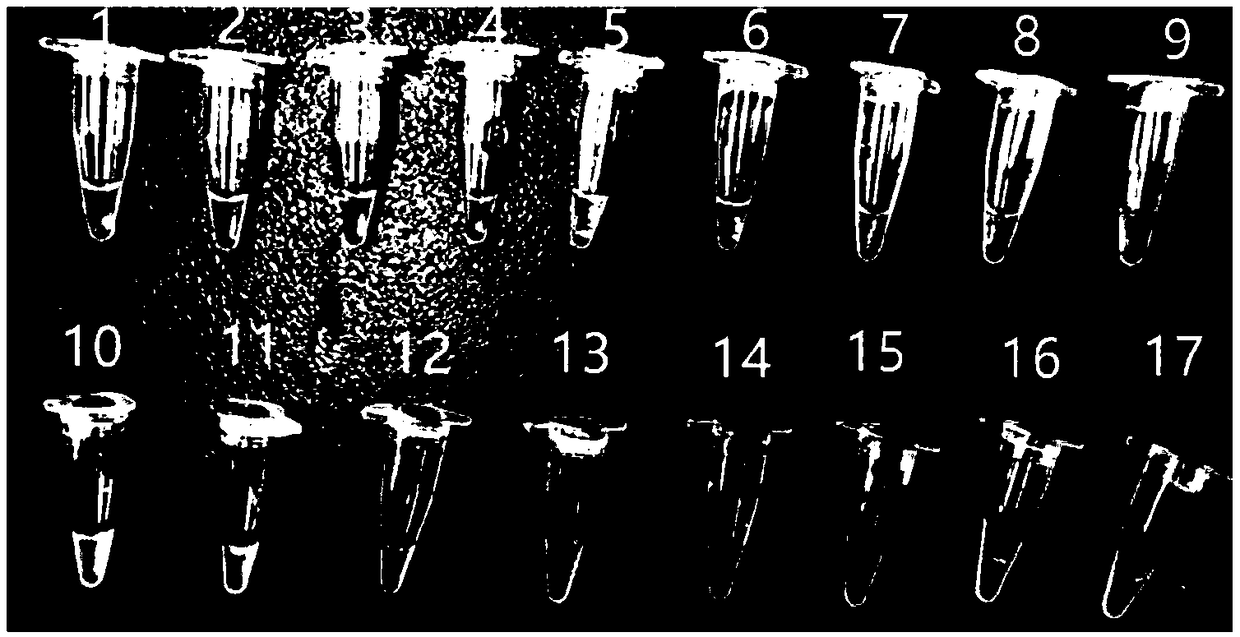Primer, kit and method for detecting bacillus coli shiga toxin through PSR (Polymerase Spiral Reaction) isothermal amplification reaction detection
A technology of Escherichia coli and Shiga toxin, which is applied in the biological field, can solve the problems of complex operation process, heavy workload, and high cost, and achieve the effect of simple and fast operation, low detection cost, and guaranteed reliability
- Summary
- Abstract
- Description
- Claims
- Application Information
AI Technical Summary
Problems solved by technology
Method used
Image
Examples
Embodiment 1
[0038] Example 1 Based on the polymerase helical reaction isothermal amplification technology to detect the microbial method of E.coli O157:H7
[0039]1. The method for detecting pathogenic microorganisms based on polymerase helical isothermal amplification technology. In this embodiment, E.coliO157:H7 is used as an example, and the reagents used are as follows:
[0040] a. The detection primer Ft aqueous solution and the Bt aqueous solution primer sequences with a concentration of 50 μM are as follows (5'-3'):
[0041] Detection primer Ft: CTCTTCAGCCAGTCGTCGTG-CAACAGCGACATCATCCG (SEQ ID NO.1);
[0042] Detection primer Bt: GTGCTGCTGACCGACTTCTC-ATTCCTTCCCGTAACAACT (SEQ ID NO.2);
[0043] b.2 × reaction stock solution: Tris-HCl with a concentration of 40.0mM, ammonium sulfate 20.0mM, potassium chloride 20.0mM, magnesium sulfate 16.0mM, 0.2% (v / v) Tween 20, betaine 1.4 M, dNTPs (each) 10.0mM mixture composition;
[0044] c. Bst DNA polymerase (large fragment, NEB company) aqu...
Embodiment 2
[0052] Example 2 Polymerase helical reaction detection Shiga toxin specificity test
[0053] Escherichia coli containing Shiga toxin (Escherichia coli E019 [1] , E. coli E020 [1] , E. coli E043 [1] , E. coli E044 [1] , Escherichia coli ATCC43895) and other strains that do not contain Shiga toxin (Salmonella ATCC29629, Salmonella ATCC19585, Salmonella ATCC14028, Salmonella ATCC 13076, Listeria monocytogenes ATCC19116, Listeria monocytogenes ATCC19114, Listeria monocytogenes ATCC19115, Pseudomonas aeruginosa Genomic DNA of Monomonas ATCC27853, Pseudomonas aeruginosa ATCC9027, Staphylococcus aureus ATCC23235, Staphylococcus aureus ATCC6358, and Vibrio parahaemolyticus ATCC17802 was established according to the above reaction system and conditions. Test.Set the genome containing Shiga toxin escherichia coli as positive control, and ultrapure water as negative control (negative control and figure 1 The results of the blank control in the same), the results are as follows figu...
Embodiment 3
[0054] Example 3PSR detects the sensitivity test of Escherichia coli Shiga toxin
[0055] The genome of Escherichia coli O157 was serially diluted 10 times to 68ng / μl, 6.8ng / μl, 680pg / μl, 68pg / μl, 6.8pg / μl, 680fg / μl, and a negative control (deionized water) was set at the same time According to the reaction system in the above-mentioned embodiment 1, the polymerase helical reaction amplification method is constructed to determine the sensitivity of the detection method, and the results are as follows image 3 shown. The results showed that the established Escherichia coli Shiga toxin polymerase helical reaction method could detect 680pg / μL of Escherichia coli DNA in the sample.
[0056] Conclusion: From the above experimental results, it can be seen that the polymerase helical reaction amplification method has the following advantages over conventional PCR and fluorescent PCR:
[0057] The operation and identification are simple and fast: the whole process of conventional PC...
PUM
 Login to View More
Login to View More Abstract
Description
Claims
Application Information
 Login to View More
Login to View More - R&D
- Intellectual Property
- Life Sciences
- Materials
- Tech Scout
- Unparalleled Data Quality
- Higher Quality Content
- 60% Fewer Hallucinations
Browse by: Latest US Patents, China's latest patents, Technical Efficacy Thesaurus, Application Domain, Technology Topic, Popular Technical Reports.
© 2025 PatSnap. All rights reserved.Legal|Privacy policy|Modern Slavery Act Transparency Statement|Sitemap|About US| Contact US: help@patsnap.com



